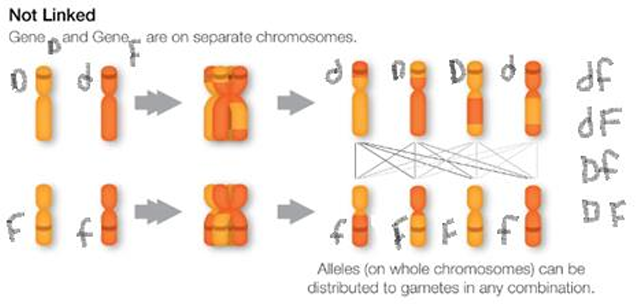Chapter 8 - Patterns of Inheritance
1/95
There's no tags or description
Looks like no tags are added yet.
Name | Mastery | Learn | Test | Matching | Spaced |
|---|
No study sessions yet.
96 Terms
Who was Johann Gregor Mendel (1822–1884)?
An Austrian scientist who taught physics, botany, and natural science, and is known as the “father of genetics”
What research did Mendel conduct starting in 1856?
He studied inheritance patterns in honeybees and plants, ultimately using pea plants as his primary model system
Was Mendel recognized for his scientific contributions during his lifetime?
No. His work was not recognized until 1900, when it was rediscovered, reproduced, and revitalized by scientists investigating the chromosomal basis of heredity.
What is genetics?
Genetics is the study of heredity — how traits are passed from parents to offspring.
What did Johann Gregor Mendel do for the field of genetics?
Mendel set the framework for genetics long before chromosomes or genes had been identified, at a time when meiosis was not well understood
How did Mendel conduct his research on heredity?
He selected a simple biological system and conducted methodical, quantitative analyses using large sample sizes to study inheritance
What did Mendel’s work reveal?
His work revealed the fundamental principles of heredity
We now know that genes, carried on chromosomes, are the basic functional units of heredity with the ability to be replicated, expressed, or mutated
What is classical or Mendelian genetics based on?
It is based on the postulates put forth by Mendel, which form the foundation of how traits are inherited
Do all traits follow Mendelian genetics?
No. Not all traits are transmitted from parents to offspring according to Mendelian genetics, but Mendel’s experiments are an excellent starting point for understanding inheritance.
What species did Mendel use to study inheritance?
Mendel’s experimental work was with the garden pea, Pisum sativum, to study inheritance
How does the garden pea (Pisum sativum) reproduce naturally?
It naturally self-fertilizes — pollen encounters ova within the same flower
Every pea plant has both male and female reproductive organs
What is a “true-breeding” pea plant?
A “true-breeding” pea plant is one that always produces offspring that look like the parent
Why did Mendel use true-breeding plants?
By using true-breeding plants, Mendel avoided the appearance of unexpected traits in offspring that might occur if the plants were not true-breeding
What is a hybridization?
Hybridization involves mating two true-breeding individuals with different traits
In peas, which are naturally self-pollinating, this is done by manually transferring pollen from the anther of one plant to the stigma of another
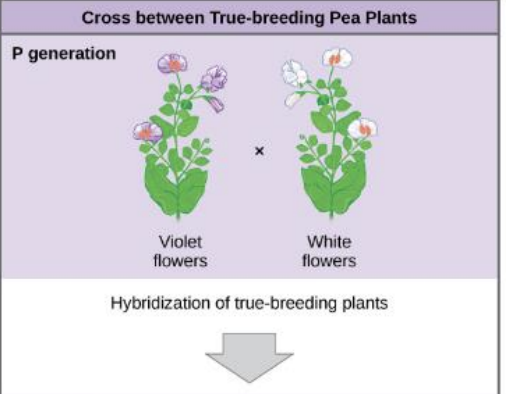
What is the P generation?
The P generation (parental generation): the plants used in the first-generation crosses
Mendel collected the seeds produced by the P plants and grew them the following season

What is the F1 generation?
The F1 generation (first filial generation): the offspring from the P generation plants
Mendel examined the F1 characteristics, then allowed them to self-fertilize naturally, collecting and growing their seeds
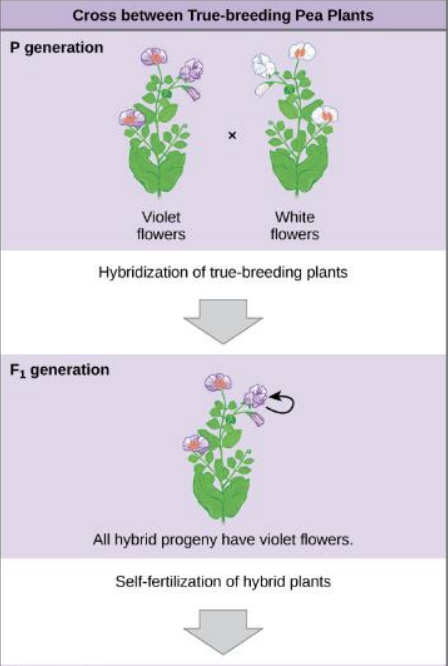
What is the F2 generation?
The F2 generation (second filial generation): the offspring from the F1 generation plant
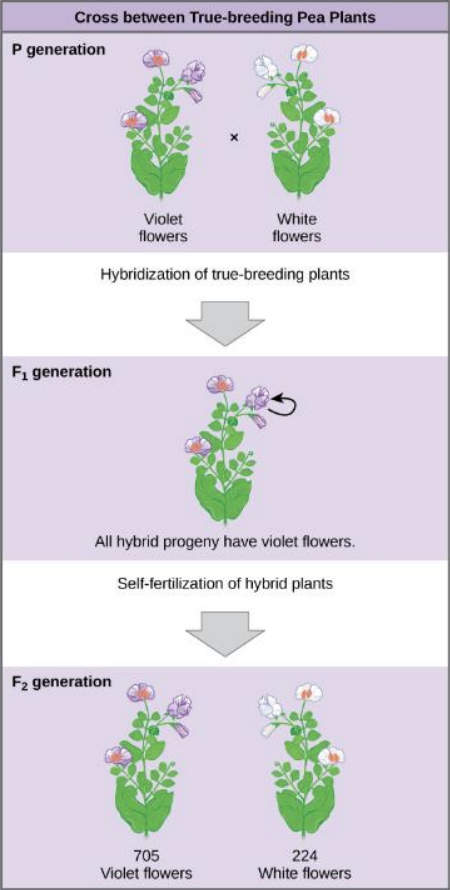
Did Mendel continue beyond the F2 generation?
Yes. Mendel’s experiments extended beyond the F2 to the F3, F4, and so on, but the ratios of characteristics in the P, F1, and F2 generations were the most significant and became the basis of Mendel’s postulates.
In his 1865 publication, what did Mendel report?
Mendel reported the results of his crosses involving seven different characteristics, each with two contrasting traits
What characteristics did Mendel study in pea plants?
Plant height
Seed texture
Seed color
Flower color
Pea-pod size
Pea-pod color
Flower position
What is the definition of a trait?
A variation in the physical appearance of a heritable characteristic
For the characteristic of flower color, what were the two contrasting traits?
White versus purple
How did Mendel confirm that he was using plants that bred true for flower color?
All self-crossed offspring of parents with white flowers had white flowers, and all self-crossed offspring of parents with purple flowers had purple flowers
Aside from flower color, what else did Mendel confirm about the pea plants?
Other than flower color, the pea plants were physically identical
What occurred in Mendel’s P Generation cross? What were the results?
He crossed a true-breeding purple flower with a true-breeding white flower
All offspring in the F1 generation were purple = hybrid
The white flower trait had completely disappeared in the F1 generation
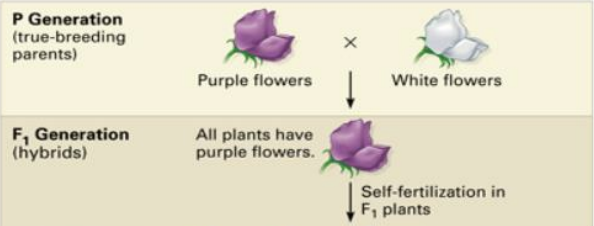
What happened in Mendel’s F1 Generation cross?
All purple hybrid flowers were allowed to self-fertilize
In the F2 generation, there were ¾ purple flowers (75%) and ¼ white flowers (25%)
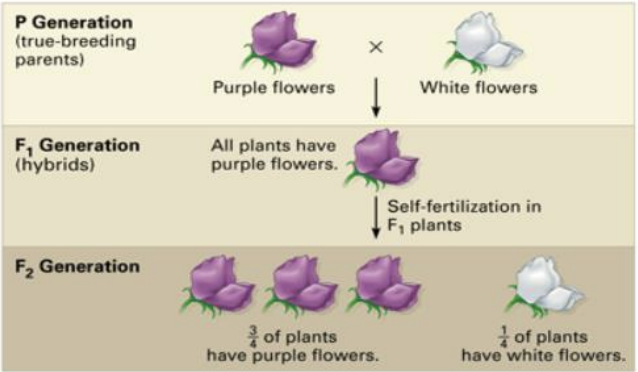
What pattern did Mendel observe about traits from F1 to F2?
One of the two traits would disappear completely from the F1 generation, only to reappear in the F2 generation at a ratio of roughly 3:1

Define dominant traits
Traits that are inherited unchanged in a hybridization
(Example: Purple flowers)
Define recessive traits
Traits that become latent, or disappear in the offspring of a hybridization, but reappear in the progeny of the hybrid offspring
(Example: White flowers)
What did Mendel propose about copies of traits in plants?
Plants possessed two copies of the trait for flower color, and each parent transmitted one of their two copies to their offspring, where they came together
What does the observation of a recessive trait indicate?
The organism lacked any dominant versions of this characteristic
What are homologous chromosomes?
Chromosomes that are the same length and have specific nucleotide segments called genes in exactly the same location, or locus
What is a gene?
A specific nucleotide sequence that determines a specific characteristic by coding for a specific protein
What is a locus?
A genetic locus is the location of a particular gene on a chromosome
What is a trait (in terms of a gene)?
The different forms of a characteristic.
Example: Shape of earlobes is a characteristic with traits of free or attached.
Why does a diploid organism have two copies of each gene (in cases where a single gene controls a single characteristic)?
Because we inherit one copy from each parent
When a single gene controls a single characteristic, what can happen with the two genetic copies?
They may or may not encode the same version of that characteristic
What is an allele?
Gene variants that arise by mutation and exist at the same relative locations on homologous chromosomes
What is a phenotype?
Physical appearance, the observable traits expressed by an organism
What is a genotype?
An organism’s underlying genetic makeup
In Mendel’s pea plants, which seed color allele is dominant and which is recessive?
Yellow-seed allele = dominant
Green-seed allele = recessive
What happened when true-breeding yellow seed plants were cross-fertilized with true-breeding green seed plants?
All F1 hybrid offspring had yellow seeds and were phenotypically identical to the true-breeding yellow seed parent
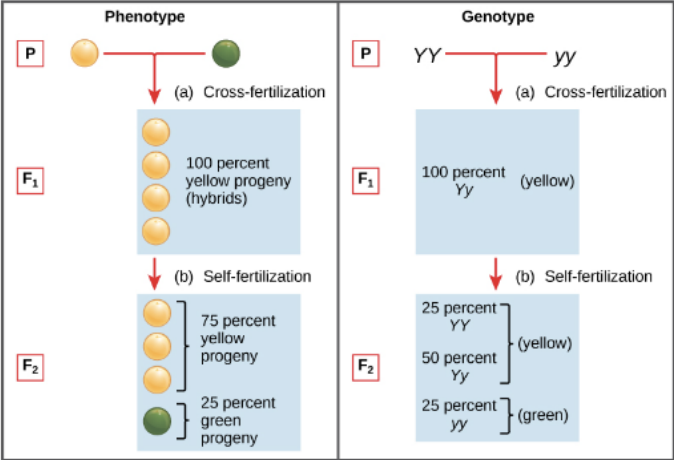
Why was the green-seed allele not lost in the F1 generation?
It reappeared in some of the F2 offspring, showing the F1 plants were genotypically different from the yellow-seed parent

What is a homozygous genotype?
Having two identical alleles, one on each homologous chromosome
What is homozygous dominant and homozygous recessive?
Homozygous dominant = two identical dominant alleles (YY)
Homozygous recessive = two identical recessive alleles (yy)
How are alleles represented in a genotype?
The genotype is written as letters (e.g., YY or yy); dominant alleles are capitalized, recessive alleles are lowercase
The letter is used to represent the gene
What is a heterozygous genotype?
One dominant allele and one recessive allele (Yy)
What is Mendel’s law of dominance?
In a heterozygote (Aa), one trait (the dominant allele) will conceal the presence of another trait for the same characteristic
What happened when Mendel crossed true-breeding purple-flowered plants with true-breeding white-flowered plants?
All of the offspring were purple-flowered, even though they all had one allele for purple and one allele for whit
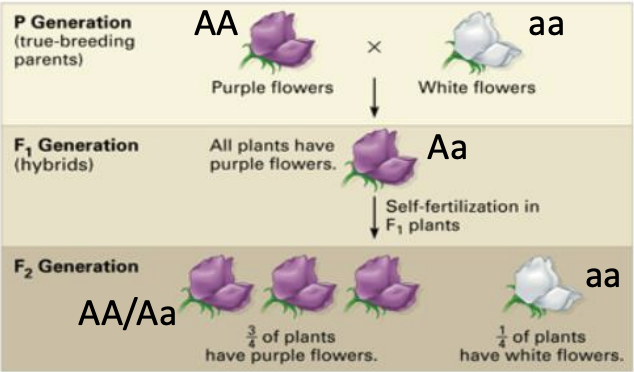
Which allele is expressed in a heterozygote?
The dominant allele will be expressed exclusively
What happens to the recessive allele in a heterozygote?
It will remain latent but will be transmitted to offspring in the same way as the dominant allele
When is the recessive trait expressed?
Only when offspring have two copies of the recessive allele (aa)
What is a monohybrid cross?
When fertilization occurs between two true-breeding parents that differ by only one characteristic
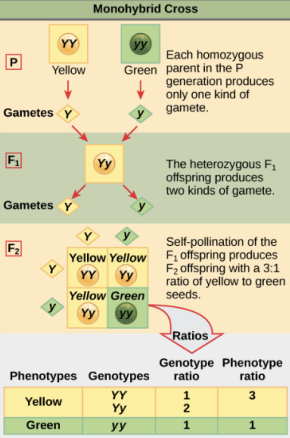
What is a Punnett square?
A diagram that predicts all possible outcomes of all possible random fertilization events and their expected frequencies
How is a Punnett square prepared?
All possible combinations of parental alleles (genotypes of gametes) are listed along the top (for one parent) and side (for the other parent) of a grid

What does each box in a Punnett square represent?
The diploid genotype of a zygote (fertilized egg) formed from the combination of egg and sperm alleles
What can be calculated from a Punnett square?
Genotypic and phenotypic ratios
What is Mendel’s Law of Segregation?
Alleles must segregate equally into gametes during meiosis, so each gamete is equally likely to receive either one of the two alleles, and offspring have an equal likelihood of inheriting either allele
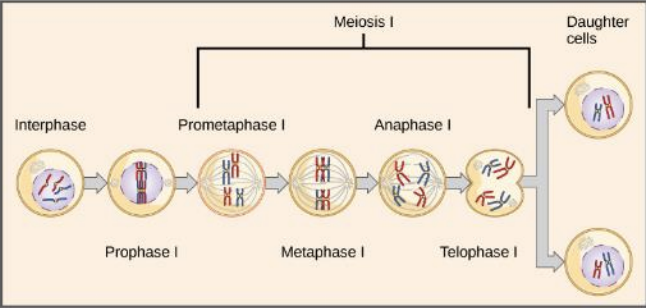
What did Mendel develop to determine if a dominant-expressing organism was a heterozygote or a homozygote?
A test cross
What is a test cross?
When the dominant-expressing organism is crossed with an organism that is homozygous recessive for the same characteristic
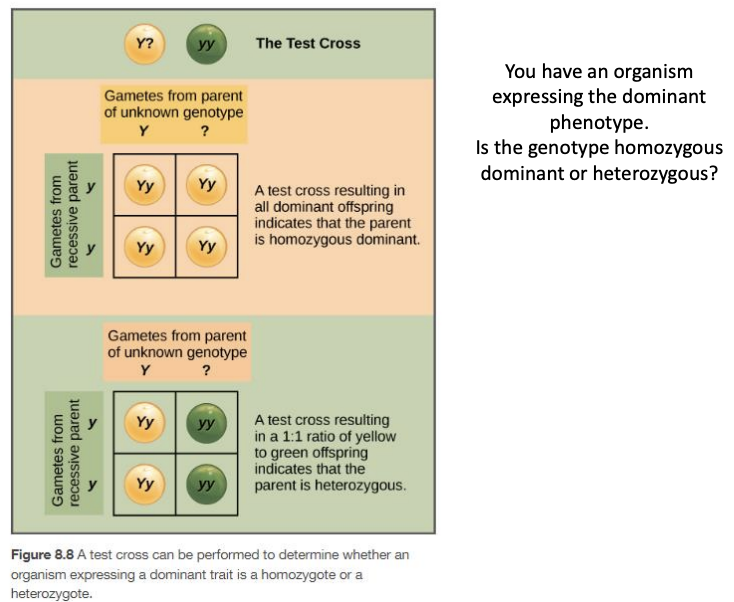
What happens if the dominant-expressing organism is homozygous dominant (YY)?
All F1 offspring will be heterozygous and express the dominant trait
What happens if the dominant-expressing organism is heterozygous (Yy)?
The F1 offspring will exhibit a 1:1 ratio of heterozygous and homozygous recessive
How do you determine the genotype of an organism with the test cross?
Determining the Genotype with a Test Cross
Cross the organism with the dominant phenotype: with an organism that is homozygous recessive for the trait.
Observe the offspring:
If the offspring all show the dominant phenotype, the original organism was homozygous dominant.
If some offspring show the dominant phenotype and some show the recessive phenotype (a 1:1 ratio), the original organism was heterozygous
What is Mendel’s law of independent assortment?
Genes do not influence each other with regard to the sorting of alleles into gametes
Every possible combination of alleles for every gene is equally likely to occur
What is the physical basis for the law of independent assortment?
It lies in meiosis I, where different homologous pairs line up next to each other in random orientations during metaphase I
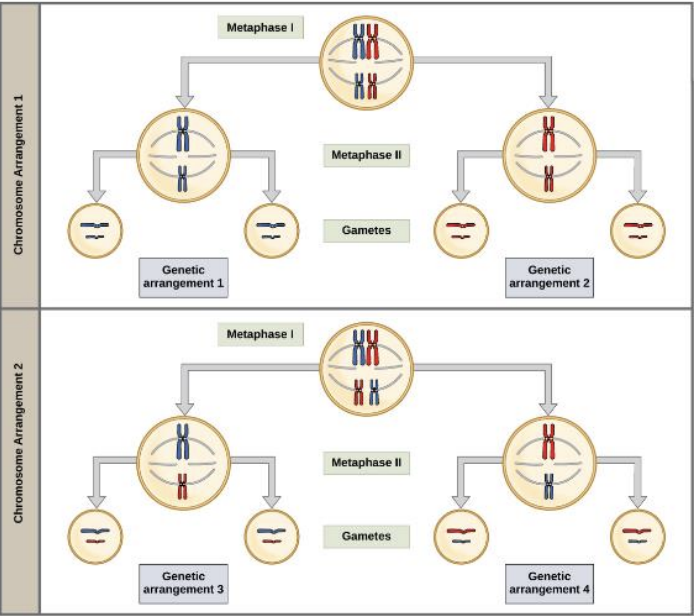
Why can each gamete contain any combination of paternal and maternal chromosomes?
Because the orientation of tetrads on the metaphase plane is random.
What type of traits did Mendel study in pea plants?
Traits with only one mode of inheritance, following a simple pattern of dominant and recessive alleles for a single characteristic
What have scientists discovered about inheritance since Mendel’s work? What have genetic studies shown since Mendel’s time?
Several important modes of inheritance exist that do not follow the dominant and recessive, single-gene model
Much more complexity exists in inheritance, but the fundamental principles of Mendelian genetics still hold true
What did Mendel’s experiments with pea plants suggest (alternatives to dominance and recessiveness)?
Two types of alleles exist for every gene
Alleles maintain their integrity in each generation (no blending)
In the presence of the dominant allele, the recessive allele is hidden, with no contribution to the phenotype
What does it mean for a recessive allele to be “carried”?
Recessive alleles can be “carried” and not expressed by individuals
Such heterozygous individuals are sometimes referred to as “carriers” (Dd)
What is incomplete dominance?
When one of the alleles appears in the phenotype in the heterozygote, but not to the exclusion of the other, which can also be seen
A genetic inheritance pattern where neither allele completely masks the other, resulting in a heterozygous offspring having a phenotype that is an intermediate blend of the two parental traits
What phenotype does a heterozygote express in incomplete dominance?
Heterozygotes expresses an intermediate phenotype the dominant and recessive phenotypes
What is an example of incomplete dominance in snapdragons (Antirrhinum majus)?
A cross between a homozygous white-flowered plant (CWCW) and a homozygous red-flowered plant (CRCR) produces offspring with pink flowers (CRCW)
A classic example is the snapdragon flower, where a cross between red-flowered and white-flowered plants produces pink-flowered offspring

Why are different genotypic abbreviations used in incomplete dominance examples?
To distinguish these patterns from simple dominance and recessiveness
Instead of using a capital for the dominant allele and a lowercase for the recessive; different capital letters, or a capital and a symbol like an apostrophe (e.g., CR and CW, or R and R'), are used to represent two distinct alleles where neither fully masks the other
What causes the pink flower phenotype in snapdragons?
The allele for red flowers is incompletely dominant over the allele for white flowers, resulting in the intermediate pink phenotype
What is codominance?
Codominance is when both alleles for the same characteristic are simultaneously expressed in the heterozygote
Neither allele is masked, so both traits appear in the phenotype
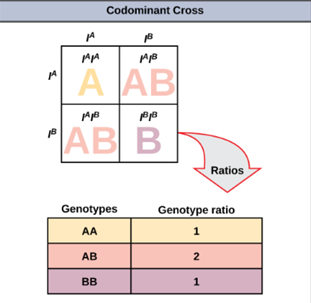
What is an example of codominance?
In the ABO blood groups of humans, the A and B alleles are expressed as A or B molecules on the surface of red blood cells
Homozygotes (IAIA or IBIB) show either A or B phenotype, while heterozygotes (IAIB) express both phenotypes equally
Can individual humans have more than two alleles for a gene?
No, each individual human (and all diploid organisms) can only have two alleles for a given gene, but multiple alleles may exist at the population level
What is the “wild type” in a population with multiple alleles?
The most common phenotype or genotype in the natural population, often abbreviated “+” when many alleles exist for the same gene
All other phenotypes or genotypes are considered variants (mutants), which can be dominant or recessive to the wild-type allele
Give an example of multiple alleles in humans.
The ABO blood-type system, which has three alleles:
IA codes for A molecules on red blood cells
IB codes for B molecules on the surface of red blood cells
i codes for no molecules on red blood cells
How do the ABO alleles interact?
The IA and IB alleles are codominant with each other and are both dominant over the i allele
How many genotypes and phenotypes exist with three alleles?
Each individual only gets two of the alleles from their parents
There are six different genotypes when there are three alleles
The number of possible phenotypes depends on the dominance relationships between the three alleles
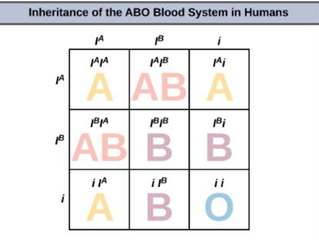
What is the difference between human male and female sex chromosomes?
Human females have a homologous pair of X chromosomes (XX), while males have an XY pair
The Y chromosome is shorter and has fewer genes, but shares a small region of similarity to the X chromosome so that they can pair during meiosis
What does it mean if a gene is “X-linked”?
It means the gene is present on the X chromosome but not on the Y chromosome
What was the first X-linked trait identified, and in what organism?
Eye color in Drosophila (fruit flies) was the first X-linked trait discovered
The wild-type eye color is red (XW) and is dominant to white eye color (Xw)w
What does “hemizygous” mean, and how does it apply to Drosophila males?
Hemizygous means having only one allele for an X-linked characteristic
Male flies lack the white gene on the Y chromosome, so their genotype can only be XWY (50% red) or XwY (50% white)
What are the possible genotypes and phenotypes for Drosophila females?
Females have two allele copies of this gene (characteristic):
XᵂXᵂ or XᵂXʷ = red eyes (66%)
XʷXʷ = white eyes (33%)
Discoveries in fruit fly genetics can be applied to human genetics: What happens when a female parent is homozygous for a recessive X-linked trait?
She will pass the trait to 100% of her male offspring, since males inherit the Y chromosome from their father
Why are X-linked traits more common in males?
Because males have only one X chromosome, a single recessive allele is enough to express the trait. Females need two copies to show it.
What are examples of X-linked conditions in humans?
Some forms of color-blindness, hemophilia, and muscular dystrophy are X-linked
What does it mean for a female to be a “carrier” of an X-linked disease?
A heterozygous female carries the recessive allele but does not show symptoms
She will pass the disease to half of her sons and carrier status to half of her daughters
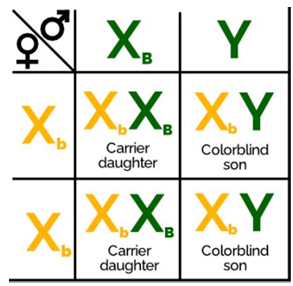
Did all of Mendel’s pea plant traits follow the law of independent assortment?
Yes, but we now know that some allele combinations are not inherited independently of each other
What happens to genes that are far apart on the same chromosome?
Because of recombination (crossover), they can behave independently, as if they are not linked
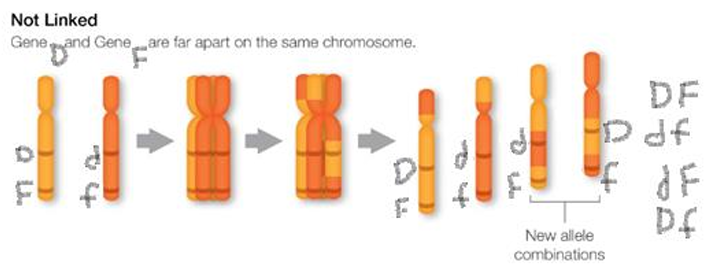
What happens to genes that are close together on the same chromosome?
They display linkage, meaning they are more likely to be inherited as a pair

What happens to genes located on different, non-homologous chromosomes?
They will always sort independently, just as Mendel observed
